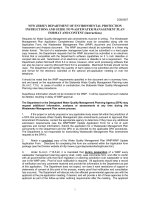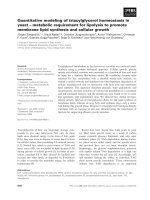Littoral Combat Ships - Relating Performance to Mission Package Inventories, Homeports, and Installation Sites potx
Bạn đang xem bản rút gọn của tài liệu. Xem và tải ngay bản đầy đủ của tài liệu tại đây (706.52 KB, 143 trang )
This document and trademark(s) contained herein are protected by law
as indicated in a notice appearing later in this work. This electronic
representation of RAND intellectual property is provided for non-
commercial use only. Permission is required from RAND to reproduce, or
reuse in another form, any of our research documents.
Limited Electronic Distribution Rights
Visit RAND at www.rand.org
Explore RAND National Defense
Research Institute
View document details
For More Information
This PDF document was made available
from www.rand.org as a public service of
the RAND Corporation.
6
Jump down to document
THE ARTS
CHILD POLICY
CIVIL JUSTICE
EDUCATION
ENERGY AND ENVIRONMENT
HEALTH AND HEALTH CARE
INTERNATIONAL AFFAIRS
NATIONAL SECURITY
POPULATION AND AGING
PUBLIC SAFETY
SCIENCE AND TECHNOLOGY
SUBSTANCE ABUSE
TERRORISM AND
HOMELAND SECURITY
TRANSPORTATION AND
INFRASTRUCTURE
WORKFORCE AND WORKPLACE
The RAND Corporation is a nonprofit
research organization providing
objective analysis and effective
solutions that address the challenges
facing the public and private sectors
around the world.
Purchase this document
Browse Books & Publications
Make a charitable contribution
Support RAND
This product is part of the RAND Corporation monograph series.
RAND monographs present major research findings that address the
challenges facing the public and private sectors. All RAND mono-
graphs undergo rigorous peer review to ensure high standards for
research quality and objectivity.
Brien Alkire • John Birkler • Lisa Dolan • James Dryden
Bryce Mason • Gordon T. Lee • John F. Schank • Michael Hayes
Prepared for the
United States Navy
Approved for public release;
distribution unlimited
NATIONAL DEFENSE RESEARCH INSTITUTE
Littoral Combat
Ships
Relating Performance
to Mission Package Inventories,
Homeports, and Installation Sites
The RAND Corporation is a nonprofit research organization providing
objective analysis and effective solutions that address the challenges
facing the public and private sectors around the world. RAND’s
publications do not necessarily reflect the opinions of its research clients
and sponsors.
R
®
is a registered trademark.
© Copyright 2007 RAND Corporation
All rights reserved. No part of this book may be reproduced in any
form by any electronic or mechanical means (including photocopying,
recording, or information storage and retrieval) without permission in
writing from RAND.
Published 2007 by the RAND Corporation
1776 Main Street, P.O. Box 2138, Santa Monica, CA 90407-2138
1200 South Hayes Street, Arlington, VA 22202-5050
4570 Fifth Avenue, Suite 600, Pittsburgh, PA 15213-2665
RAND URL: />To order RAND documents or to obtain additional information, contact
Distribution Services: Telephone: (310) 451-7002;
Fax: (310) 451-6915; Email:
Library of Congress Cataloging-in-Publication Data is available for this publication.
ISBN 978-0-8330-4146-3
Cover Design by Stephen Bloodsworth
The research described in this report was prepared for the United States
Navy. The research was conducted in the RAND National Defense
Research Institute, a federally funded research and development center
sponsored by the Office of the Secretary of Defense, the Joint Staff,
the Unified Combatant Commands, the Department of the Navy,
the Marine Corps, the defense agencies, and the defense Intelligence
Community under Contract W74V8H-06-C-0002.
iii
Preface
e Littoral Combat Ship (LCS) is a relatively small surface combat-
ant vessel intended to perform littoral or coastal missions where high-
speed maneuverability, agility, and sprint speed are required. In early
2005, the U.S. Navy commissioned the RAND Corporation to evalu-
ate the operational, logistical, and cost implications of modules being
developed and put into service aboard the LCS, a new platform that,
through modular design, can be rapidly reconfigured to suit changing
tactical situations. e ships will complement America’s fleets of exist-
ing Aegis ships and new-generation DDG-1000 destroyers and CG(X)
cruisers.
1
RAND’s evaluation took place during the months immediately
before and after the keel for the first LCS, the USS Freedom, was being
prepared and laid.
2
e Freedom is the first of two LCS seaframes under
production. Able to achieve speeds of 40 to 50 knots and to maneu-
ver in waters less than 20 feet deep, these LCS seaframes will operate
in environments where employing larger, multimission ships would be
infeasible or ill-advised.
Plans call for the Freedom and each subsequent LCS to consist
of two elements: a core seaframe that includes the ship platform and
inherent combatant capabilities and a set of interchangeable modular
“plug-and-fight” mission packages that will allow the ship to be recon-
figured for antisubmarine warfare, mine warfare, or surface warfare
missions, as needed.
1
e DDG-1000 was formerly named DD(X). See Fein, 2006.
2
e Freedom’s keel was laid and authenticated on June 2, 2005 (“Keel Laid,” 2005).
Each seaframe will be able to perform a set of primary func-
tions—including self-defense; navigation; command, control, commu-
nications, computers, intelligence, surveillance, and reconnaissance;
and launching and retrieving unmanned vehicles—common to all
missions. e interchangeable mission packages will provide the LCS
with additional war-fighting capabilities and allow it to perform spe-
cialized missions. A mission package may consist of a combination of
mission modules, such as manned and unmanned vehicles, deploy-
able sensors, and mission manning detachments. e components of a
mission module predominantly fit inside several standard-size 20-foot
cargo containers. e mission modules will integrate into the seaframe,
and any LCS can hold any mission package. An LCS can be reconfig-
ured with a new mission package in a few days while laying pier side.
is modular approach raises several questions:
Where are the optimum locations for LCS homeports and mis-
sion package installation sites?
How many mission packages of each type should be procured
and when?
How many mission packages of each type should be stored on
available seaframes, at homeports, and at mission package instal-
lation sites?
What are the costs of acquiring mission packages and facilities for
homeports and installation sites?
What cost and performance trade-offs and sensitivities occur with
various combinations of the number of and the types of mission
packages?
RAND analyzed these questions between January and Novem-
ber 2005, employing both qualitative and quantitative methodologies.
is monograph describes the analytical procedures that the RAND
team followed and summarizes its findings and recommendations.
is research was sponsored by the Naval Sea System Com-
mand’s Surface Warfare Development Group and conducted within
the Acquisition and Technology Policy Center of the RAND National
Defense Research Institute, a federally funded research and develop-
•
•
•
•
•
iv Littoral Combat Ships
ment center sponsored by the Office of the Secretary of Defense, the
Joint Staff, the Unified Combatant Commands, the Department of the
Navy, the Marine Corps, the defense agencies, and the defense Intelli-
gence Community. For more information on RAND’s Acquisition and
Technology Policy Center, contact the Director, Philip Antón. He can
be reached by email at ; by phone at 310-393-
0411; or by mail at the RAND Corporation, 1776 Main Street, Santa
Monica, California 90407-2138. More information about RAND is
available at www.rand.org.
Preface v
vii
Contents
Preface iii
Figures
xi
Tables
xv
Summary
xvii
Acknowledgments
xxix
Abbreviations
xxxi
CHAPTER ONE
Introduction 1
ree Primary Missions for the LCS
3
Modular Capabilities
6
RAND’s Analysis
6
Scenario and LCS Employment Option Analyses
7
Transit, Logistics, and Cost Analyses
9
Organization of the Monograph
10
CHAPTER TWO
Employing the LCS: Scenarios and Concepts of Operation 11
How LCSs Will Be Employed
11
Scenarios at LCSs Will Encounter
12
Major Combat Operations
13
Stability Operations
14
Global War on Terrorism
15
Homeland Defense
15
Initial Locations and Readiness of LCSs and Related Assets
16
viii Littoral Combat Ships
CHAPTER THREE
Methodology and Analytical Framework 19
Analytical Models at We Used
19
Littoral Combat Ship Transshipment Model (LCSTSM)
19
Cost Models
24
Analyses at We Performed
24
CHAPTER FOUR
Preferred LCS Homeports and Mission Package Installation Sites 25
e Navy’s Expected LCS fleet
25
Criteria for Choosing Suitable Homeports and Installation Sites
26
Selecting Preferred Homeports and Installation Sites
27
Initial Analysis of 15 Sites
27
Initial Analysis of Preferred Sites for the Short Term, Middle Term,
and Long Term: 15 Sites
27
Second-Order Analysis of Preferred Sites for the Short Term,
Middle Term, and Long Term: Eight Sites
28
Testing the Sensitivity of Performance of Second-Order Sites to
Removal or Retention of Japan in the Short Term, Middle Term,
and Long Term
32
Choosing Between Guam and Japan: Cost Comparison
35
Testing the Sensitivity of Performance of Second-Order Sites to
Removal or Retention of Singapore in the Short Term,
Middle Term, and Long Term
36
Conclusion: e Same Five Sites Are Preferred for Each Time Frame
for Homeports and Mission Package Installation Sites
40
CHAPTER FIVE
Preferred LCS Mission Package Inventories 45
Assumed LCS Seaframe Inventories in the Short Term, Middle Term,
and Long Term
45
LCS Mission Package Inventories in the Short Term, Middle Term,
and Long Term
46
e Proportion of Mission Package Types Needed in the
Short Term, Middle Term, and Long Term
46
Minimum Number of Each Mission Package Type Needed in the
Short Term, Middle Term, and Long Term
47
Quantities of LCS Mission Packages, by Type, at the Navy Will
Need in the Short Term, Middle Term, and Long Term
49
Locations Where LCS Mission Packages Change-Outs Will Occur
51
Conclusion: e Number of Mission Packages the Navy Will Need
and Where ey Should Be Kept
54
CHAPTER SIX
Projected LCS and Mission Package Costs and Performance 59
Cumulative Procurement Costs for LCS Seaframes, Mission Packages,
and Facilities Construction
59
Performance of LCS With Our Recommended Inventories
and Locations
60
CHAPTER SEVEN
Additional Considerations 63
Risks and Benefits Involved With Storing and Installing Mission
Packages at Different Sites
63
Sealift
64
Airlift
65
Maintaining Performance With Fewer Mission Packages and More
Installation Sites
68
Homeport Locations and Mission Package Proportions for Scenarios
Involving MCOs Versus Scenarios Not Involving MCOs
69
CHAPTER EIGHT
Recommendations 75
Homeports and Installation Sites
75
Inventories of Mission Packages
76
eater Transit Times
76
Costs and Schedule of Acquisitions
76
Emerging Issues
80
Contents ix
x Littoral Combat Ships
APPENDIX
A. Mathematical Details of the LCS Transshipment Model 83
B. LCS Investment Cost Analysis
89
C. LCS Performance Assumptions
99
D. Navy Special Operations Forces Perspective on LCS
103
Bibliography
105
xi
Figures
S.1. Performance Metrics for Short-, Middle-, and Long-Term
Solutions
xxviii
1.1. Lockheed Martin Team LCS Design
4
1.2. General Dynamics-Bath Iron Works LCS Design
4
1.3. LCS Fleet Size, FYs 2006–2024
5
4.1. Percentage of Mission Package Change-Outs, by Location,
in the Short Term for the 15 Potential Sites
28
4.2. Percentage of Mission Package Change-Outs, by Location,
in the Middle Term for the 15 Potential Sites
29
4.3. Percentage of Mission Package Change-Outs, by Location,
in the Long Term for the 15 Potential Sites
30
4.4. Percentage of Mission Package Change-Outs, by Location,
in the Short Term for Eight Potential Sites
31
4.5. Percentage of Mission Package Change-Outs, by Location,
in the Middle Term for Eight Potential Sites
32
4.6. Percentage of Mission Package Change-Outs, by Location,
in the Long Term for Eight Potential Sites
33
4.7. Performance Metrics in the Short Term, With and
Without Japan
34
4.8. Performance Metrics in the Middle Term, With and
Without Japan
34
4.9. Performance Metrics in the Long Term, With and
Without Japan
35
4.10. Percentage of Mission Package Change-Outs in the
Short Term, With and Without Japan
36
4.11. Percentage of Mission Package Change-Outs in the
Middle Term, With and Without Japan
37
xii Littoral Combat Ships
4.12. Percentage of Mission Package Change-Outs in the
Long Term, With and Without Japan
38
4.13. Performance Metrics in the Short Term, With and
Without Singapore
39
4.14. Performance Metrics in the Middle Term, With
and Without Singapore
39
4.15. Performance Metrics in the Long Term, With and
Without Singapore
40
4.16. Percentage of Mission Package Change-Outs in the
Short Term, With and Without Singapore
41
4.17. Percentage of Mission Package Change-Outs in the
Middle Term, With and Without Singapore
42
4.18. Percentage of Mission Package Change-Outs in the
Long Term, With and Without Singapore
43
5.1. Proportion of Mission Packages Needed, by Type, to
Meet Average Scenario Demands
47
5.2. Closure Time Versus Ratio of Available Mission Packages
to Available Seaframes in the Short Term
48
5.3. Closure Time Versus Ratio of Available Mission Packages
to Available Seaframes in the Middle Term
49
5.4. Closure Time Versus Ratio of Available Mission Packages
to Available Seaframes in the Long Term
50
5.5. Inventory of Mission Packages in the Short Term as a
Function of Operational Availability
51
5.6. Inventory of Mission Packages in the Middle Term as a
Function of Operational Availability
52
5.7. Inventory of Mission Packages in the Long Term as a
Function of Operational Availability
53
5.8. Percentage Distribution of Mission Package Change-Outs,
by Type, for Each Homeport or Installation Site in the
Short Term
54
5.9. Percentage Distribution of Mission Package Change-Outs,
by Type, for Each Homeport or Installation Site in the
Middle Term
55
5.10. Percentage Distribution of Mission Package Change-Outs,
by Type, for Each Homeport or Installation Site in the
Long Term
56
6.1. Estimated Cumulative Procurement and Facility
Construction Costs for the Short Term, Middle Term,
and Long Term
61
6.2. Performance Metrics for Short-, Middle-, and Long-Term
Solutions
62
7.1. Closure Time Versus Ratio of Available Mission Packages
to Available Seaframes for the Scenario With the WP
MCO, With Five and Six Installation Sites
69
7.2. Proportion of Mission Packages, by Type, for All Mission
Demands and for Non-MCO Mission Demands
70
7.3. Percentage of Mission Package Change-Outs for
Homeports and Installation Sites to Meet All or
Non-MCO Demands
71
7.4. Percentage of ASW Mission Package Change-Outs
for Homeports and Installation Sites to Meet All or
Non-MCO Mission Demands
72
7.5. Percentage of MIW Mission Package Change-Outs
for Homeports and Installation Sites to Meet All or
Non-MCO Mission Demands
73
7.6 Percentage of SUW Mission Package Change-Outs for
Homeports and Installation Sites to Meet All or
Non-MCO Mission Demands
74
8.1. Performance Metrics for Short-, Middle-, and Long-Term
Solutions
77
8.2. Estimated Cumulative Procurement and Facility
Construction Costs for the Short Term, Middle Term,
and Long Term
78
8.3. One Possible Acquisition Schedule for Mission Packages
and VTUAVs
79
8.4. Annual Procurement Costs for Mission Packages and
VTUAVs
79
8.5. Annual Costs of Constructing Facilities for Homeports
and Installation Sites
80
C.1. Average Transit Speed as a Function of Distance
101
C.2. Range as a Function of Average Transit Speed
102
Figures xiii
xv
Tables
S.1. Mission Package Inventories in the Short Term,
Middle Term, and Long Term
xxiv
S.2. Number of Mission Packages, by Type, Stored on
Available Seaframes, at Homeports, and at Installation
Sites in the Short Term
xxv
S.3. Number of Mission Packages, by Type, Stored on
Available Seaframes, at Homeports, and at Installation
Sites in the Middle Term
xxv
S.4. Number of Mission Packages, by Type, Stored on
Available Seaframes, at Homeports, and at Installation
Sites in the Long Term
xxvi
S.5. Estimated Cumulative Procurement and Facilities
Construction Costs for the Short Term, Middle Term,
and Long Term
xxvii
4.1. Comparison of Homeport Upgrade Costs for Japan
and Guam
38
5.1. Number of Mission Packages, by Type, Stored on
Available Seaframes, at Homeports, and at Installation
Sites in the Short Term
56
5.2. Number of Mission Packages, by Type, Stored on
Available Seaframes or Stored at Homeports and
Installation Sites in the Middle Term
57
5.3. Number of Mission Packages, by Type, Stored on
Available Seaframes or Stored at Homeports and
Installation Sites in the Long Term
57
5.4. Mission Package Inventories in the Short Term,
Middle Term, and Long Term
58
xvi Littoral Combat Ships
6.1. Estimated Cumulative Procurement and Facility
Construction Costs for the Short Term, Middle Term, and
Long Term
60
6.2. Combined Cost and Performance Results
62
7.1. Port-to-Port Transit Time, in Days, for Sealift of Mission
Packages
65
7.2. Number of C-17 or C-130 Sorties Required for Airlift of
One Mission Package, Including Mission Package Payload
Weights
66
7.3. Transit Time per Sortie, in Days, and Number of Refueling
Operations for Airlift of Mission Packages with C-17 or
C-130 Aircraft
67
8.1. Mission Package Inventories in the Short Term,
Middle Term, and Long Term
76
B.1. LCS Abbreviated Cost Breakdown Structure
90
B.2. Costs of the First Unit for Mission Packages
91
B.3. Inflation Factors Applied to Mission Package
Procurement Costs
92
B.4. LCS Homeport Facilities per NAVFAC
94
B.5. Fiscal-Year 2005 Navy Military Construction Program
Project Costs
95
B.6. Bachelor Enlisted Quarters Construction Data
96
B.7. CONUS Pier Construction Cost Data
97
B.8. Construction Costs for Homeport in Guam
98
C.1. reshold, Objective, and Average Seaframe
Performance Levels as Specified in CDD for Flight 0
99
xvii
Summary
In June 2005, workers at the Marinette Marine shipyard in Marinette,
Wisconsin, laid the keel for the USS Freedom, the Navy’s first Littoral
Combat Ship.
1
e LCS constitutes a new class of fast, agile, and net-
worked warships designed to overcome threats in shallow waters posed
by mines, diesel-electric submarines, fast-attack craft, and fast inshore
attack craft.
LCSs will be key components in a proposed family of next-
generation surface combatants that also includes the much larger
DDG-1000 destroyer and a future CG(X) cruiser.
2
LCSs will be able
to deploy independently to overseas littoral regions; remain on station
for extended periods of time, either with a carrier strike group or an
expeditionary strike group or through a forward-basing arrangement;
operate independently and/or with other LCS units; and be replen-
ished while under way.
LCSs: Transformational Capabilities and Modular Mission
Packages
LCSs will bring an array of transformational capabilities to the Navy.
Able to achieve speeds of 40 to 50 knots and maneuver in waters less
than 20 feet deep, LCSs will operate in environments where employ-
1
e Freedom’s keel was laid and authenticated on June 2, 2005 (“Keel Laid,” 2005).
2
e DDG-1000 was formerly named DD(X). See Fein, 2006. In addition, there is also
considerable interest in LCS modules for future U.S. Coast Guard applications as part of the
service’s Integrated Deepwater System.
xviii Littoral Combat Ships
ing larger, multimission ships would be infeasible or ill-advised. ey
will be networked into the fleet, operating as part of a distributed force;
sharing tactical information with other Navy aircraft, ships, subma-
rines, and joint units; and launching manned and unmanned vehi-
cles to execute missions. ey will incorporate advanced technologies,
employing cost optimized advanced weapons; sensors; data fusion;
command, control, communications, computers, intelligence, surveil-
lance, and reconnaissance (C4ISR) systems; hull forms; propulsion sys-
tems; manning concepts; smart control systems; and self-defense sys-
tems (U.S. Navy Littoral Combat Ship Web site, not dated).
But perhaps the most transformational features of LCSs will be
their modular capabilities. Plans call for Freedom and each subsequent
LCS to consist of two elements:
a core seaframe that includes the ship platform and inherent com-
batant capabilities. Each seaframe will be able to perform a set
of primary functions—including self-defense, navigation, C4I,
and launching and retrieving unmanned vehicles—that will be
common to all missions.
a set of interchangeable modular “plug-and-fight” mission pack-
ages that will allow the ship to be reconfigured, as needed, for
antisubmarine warfare (ASW), mine warfare (MIW), or surface
warfare (SUW) missions. A mission package may consist of a
combination of mission modules, such as manned and unmanned
vehicles, deployable sensors, and mission manning detachments.
e components of a mission module predominantly fit inside
several standard-size 20-foot cargo containers.
3
e mission mod-
ules will integrate into the seaframe, and any LCS can hold any
mission package.
4
An LCS can be reconfigured with a new mis-
sion package in a few days while laying pier side.
3
Standard 20-foot cargo containers measure 20 feet in length, 8 feet in width, and 8.5 feet
in height. A standardized form factor is designed to allow them to be loaded on ships, trucks,
and railroad cars.
4
Our study assumed that all seaframes could operate with all mission packages, which was
consistent with U.S. Navy planning at the time of the study. However, it is probable that
•
•
Summary xix
At the time of the study, Navy plans included acquisition of one
seaframe in fiscal year (FY) 2005, an additional seaframe in FY 2006,
two seaframes in FY 2007, and three in FY 2008, after which the
Navy would begin acquiring five a year.
5
At that pace, the short-term
inventory of seaframes could reach 36 by FY 2014, the middle-term
inventory of seaframes could reach 60 by FY 2019, and the long-term
inventory of seaframes could reach 84 by FY 2024.
Issues We Addressed
In early 2005, RAND was commissioned by the LCS Program Office
6
to help it think through the cost and logistics implications of modular
mission packages planned for the LCSs. In particular, the LCS Pro-
gram Office was interested in gaining a clearer understanding of opera-
tional, logistics, and cost trade-offs between three interdependent ele-
ments of the program: the number of LCSs in the fleet, the number of
mission packages
7
that those LCSs would require to perform a range of
missions, and the number of and the locations of LCS homeports and
mission package installation sites.
Methods and Data We Used
RAND analyzed these issues between January and November 2005,
employing both qualitative and quantitative methodologies to examine
there will be upgrades and modernization efforts that may pose challenges for maintaining
compatibility.
5
After the conclusion of the study, the Quadrennial Defense Review recommended an
increase in the Navy’s annual procurement of LCSs. Francis, 2006, indicates up to six ships
per year from 2009 through 2011, for a total of 55 through 2029. See also Cava, 2006.
6
e official name of our sponsor is PMS 501, LCS Program Office.
7
Aviation assets were assumed to be collocated with other mission package components
for the purposes of this analysis. e scope of this project did not allow for evaluation of the
number of aviation assets separately from mission packages.
xx Littoral Combat Ships
the LCS fleet at three discrete points in the future: the short term (by
2014), middle term (by 2019), and long term (by 2024).
Qualitative Analyses: Scenarios and LCS Employment Options
To gain an understanding of what the LCS fleet might encounter over
the short, middle, and long term, we examined the LCS concept of
operations (LCS CONOPS) (U.S. Navy, 2004) in conjunction with
the strategic environment laid out in the 2005 National Defense Strat-
egy and amplified in various U.S. Navy documents (U.S. Navy, 2003
and 2005).
8
is research led to various scenarios in which the ships
might be expected to play a part through 2024. Every scenario that we
evaluated involved a simultaneous operation from each of the follow-
ing four categories:
Major Combat Operations (MCOs)—for example, responding to a
crisis in the Western Pacific, Southwest Asia, or Northeast Asia.
Global War on Terrorism Operations—for example, responding to
a chemical weapons attack on UN forces, clearing mines laid by
terrorists in sea lanes, or eliminating terrorist training camps.
Stability Operations—for example, providing humanitarian assis-
tance and disaster relief, supporting a friendly government against
insurgents, providing maritime security for oil platforms, provid-
ing forward presence and maritime interdiction operations in the
vicinity of shipping lanes, or participating in ASW exercises/sub-
marine tracking.
Homeland Defense Operations—for example, providing security
and humanitarian assistance/disaster relief following terrorist
attacks on U.S. seaports, providing security and humanitarian
assistance/disaster relief following a natural disaster along the
U.S. seaboard, or providing humanitarian assistance following a
refugee crisis in the Caribbean.
8
Our specific terms mirror “e Evolving Strategic Environment” as shown in Figure 1 of
U.S. Navy, 2005.
•
•
•
•
Summary xxi
We also examined how the Navy plans to use LCSs. e LCS
CONOPS describes plans for the Navy to embed LCSs in carrier strike
groups or expeditionary strike groups, to deploy them independently,
or to operate them as forward deployed units. Using these deploy-
ment concepts and potential threat characteristics, we evaluated ways
in which the Navy might employ LCSs in the context of each sce-
nario. is allowed us to develop baseline LCS requirements, includ-
ing expected modes of employment, operating locations, and mission
tasking.
Quantitative Analyses: Transit, Logistics, and Cost Modeling
Once we had analyzed the scenarios that LCS might encounter and the
ways that the Navy plans to use the vessels, we turned to our quanti-
tative analyses. As a first step, we derived measures of effectiveness for
the LCS. Because a key capability of the LCS is its ability to respond
quickly to a crisis, we used the time required for all LCSs to close on
the theaters of operation as our principal measure of effectiveness—
we term this metric “total closure time.”
9
We also derived other met-
rics—the number of LCS days spent in the littoral region of an area of
operation in advance of a strike group, the time it takes for each LCS
to arrive on station, the time it takes for each strike group to arrive
on station, the number of mission package reconfigurations by type
and geographic location, and the number of refueling-at-sea operations
required by each LCS to reach theaters of operation.
Once we had derived metrics, we developed a series of analyti-
cal tools to evaluate them. ese tools allowed us to make trade-offs
among different numbers of mission packages for the proposed number
of LCSs and the locations of LCS homeports and mission package
installation sites.
10
e main analytical tool that we developed was a model that we
called the LCS Transshipment Model (LCSTSM). Derived from a
9
Our analytical framework allows prioritization of closure time for LCSs in different oper-
ations; we treated them all with equal priority for this study rather than making assumptions
on the future priorities of government decisionmakers.
10
We assume that homeports include a mission package installation site.
xxii Littoral Combat Ships
well-known class of transshipment models, the LCSTSM enabled us
to depict how the LCS would perform under a variety of assumptions.
Other models that we developed allowed us to estimate the costs of
procuring seaframes and mission packages and of constructing LCS
homeports and installation site facilities.
Using the LCSTSM, we varied operational and logistics elements
of the LCS, including
the number of seaframes
the number of mission packages
the locations of homeports
the locations of installation sites.
We then ran multiple computer simulations with randomly
selected scenarios, locations from which LCSs would start their mis-
sions, and differing availability of assets. ese simulations yielded the
metrics. We examined how the average values of those metrics were
affected by varying the operational and logistical elements. is infor-
mation allowed us to identify the optimal locations for homeports and
installation sites and the optimal sizes for mission package inventories.
We then used our cost models to estimate annual and total costs to
procure those mission package inventories and construct homeports
and installation sites.
Preferred Homeports and Installation Sites
We analyzed 15 locations around the world as potential LCS home-
ports or installation sites.
11
Using the LCSTSM, we tested those loca-
tions across a range of scenarios and mission package inventories to
determine the sites that LCSs would most frequently visit to install or
swap mission packages in the short, middle, and long term.
11
Bahrain; Darwin and Fremantle, Australia; Diego Garcia; Guam; Japan; Mayport, Nor-
folk, Pascagoula, San Diego, and Hawaii in the United States; the western and eastern Medi-
terranean; Puerto Rico; and Singapore. We assume that an LCS homeport includes a mission
package installation site.
•
•
•
•
Summary xxiii
We found that 3 of the 15 locations were best supported as home-
ports by our analysis in all three time frames—Norfolk, San Diego,
and Japan—and two as mission package installation sites—Singapore
and Bahrain.
12
Preferred LCS Mission Package Inventories
We used the three preferred locations for LCS homeports and the two
preferred locations for installation sites to help calculate the best LCS
mission package inventories in the short, medium, and long term. We
employed a three-step process to make this calculation. For each time
frame, we
evaluated the average proportion of each LCS mission package
type that the Navy would need to meet scenario demands
estimated the minimum number of each LCS mission package
type that the Navy needs to optimize total closure time
determined the quantities of each LCS mission package type that
the Navy will need at each preferred location.
e results of this mission package inventory analysis are sum-
marized in Table S.1, which shows the number of ASW, MIW, and
SUW missions package inventories identified by our analysis for each
time period.
Summing the mission package quantities listed in Table S.1 by
type, we see that our analysis suggests the Navy will need a total of 89
mission packages in the short term, 104 in the middle term, and 126 in
the long term to meet scenario needs with minimal closure time across
the LCS fleet.
12
e political sensitivities and space limitations for an installation site in Bahrain may be
more significant than anticipated during the course of our study. A reexamination of this
prospect was outside the scope of our charter. However, we would hypothesize that a location
in the eastern or central Mediterranean might provide a suitable alternative. is hypothesis
is supported by excursions discussed in this monograph, but it should be examined more
carefully.
•
•
•









